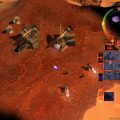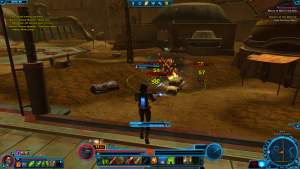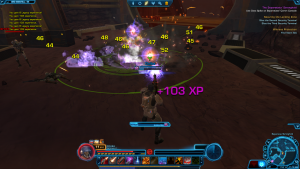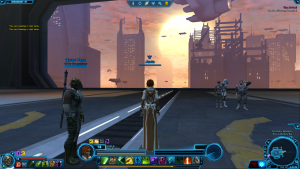- Star Wars: Knights of the Old Republic
- Star Wars: Knights of the Old Republic II: The Sith Lords
- Star Wars: The Old Republic

Bioware’s return to Star Wars before the Disney buy out and after they handed off LucasArts’ ridiculous time tables to Obsidian is something people have had a lot of thoughts on, and most of those thoughts range from “meh” to “this is literally the titanic, look at this epic meme I made expressing this, fellow gamers.” The fact that Bioware thought it was a good idea to take what was then still the most popular, critical acclaimed game they made besides Mass Effect 2 and do a follow-up via chasing that sweet, sweet World of Warcraft cash cow instantly raised eyebrows, and the past decade has been a bizarre mixture of questionable decisions, gay planets, and Bioware Austin being terrified of their fanbase while also being frustrated for about half that time at the main office ignoring every lesson they learned with online games during Anthem‘s production.

You need to keep in mind that TOR is not a failure of a game. It seems to have managed a billion dollar lifetime revenue gain with a starting budget of $200 million, which is nothing to sneeze at, but it took a lot of changes to get there. At launch, the game was subscriber only and had about a million users from the get go, who then quickly started to bleed out. In just one year, the game went free to play, and microtransactions ended up being mixed into the game, resulting in its current form of locking fast jogging at level ten unless you make an in-game purchase, and a ton of other perks behind a subscriber wall. It was a good call, though, managing the save the game by giving it a more stable user base and economy that allowed the game to survive (the ethics of these strategies more debatable).
What makes TOR so odd is that Bioware was approaching the MMORG framework from their CRPG single player design viewpoint, which gives it a lot of strange elements that still remain in the current game today. They treated this like KOTOR 3 through 10 at development start, with eight different and fleshed out story campaigns, divided between Republic and Imperial characters so their MMO could have a faction system. On the light side were the Jedi Knight, Jedi Consular, Republic Trooper, and a Solo-like Smuggler, while the dark followed the Sith Warrior, Sith Inquisitor, Imperial Intelligence Agent, and a Fett-familiar Bounty Hunter. Each character story is a reverse of one from the other side, with shared base class mechanics that feed into expected MMO archetypes (DPS, tank, healer, ect). Each class also has two advanced class variants (usually offense/defense, offense/stealth, or offense/support) with further specialization to pick out from there once you reach level ten.

Each campaign works out like a traditional Bioware campaign. Set three centuries after the events of the previous KOTOR games, you follow linear stories, make moral choices, travel the galaxy, and gather a quirky collection of party members along the way. Said party members are all the same mechanically these days, though. They used to be based around a particular stat or function focus, but fans complained that a lot of campaigns kept locking the healer past the halfway point of the story so now you can just make them whatever role you want them to play. There were also a few you could kill off or miss through your choices, but that also changed because it would result in players losing the party member their class needed most – which is now moot because all the party members are the same.
There were many, many more missteps made over the course of the game’s constant development and updates. Perhaps most famous is the gay planet (the only planet that let you trigger some same sex romance options) that was hidden behind a pay wall of an expansion, in response to a lack of gay or lesbian romance options in the base campaigns. These days, further story expansions have made a few characters bisexual you can pursue there, though though still only in further expansion stories. Not to say all the hetero romance options are bad, as a female bounty hunter can femdom a Mandalorian Johnny Yong Bosch, but it was frustrating indeed.

There’s all sorts of new bells and whistles these days, including customizable strongholds, spaceship dogfight missions, and a stronger PVP mode, but the core game has been mostly kept the same, and as a single player experience, it’s not too bad. You get a lot of options for building your characters, and the story campaigns are surprisingly strong. The Jedi stories suffer from hippy fart smelling that usually comes with light side Jedi stories, but the Smuggler was a surprising stand out in that they’re a huge moron with a mess of dumb luck no matter how you play them. You can flit with basically everyone too, which is hilarious.
On the Imperial side, a light side run as either Sith character manages to dive a few toes in KOTOR 2 territory with deconstructive elements, and you get the most entertaining party members in the game. The real highlight here is the Imperial Agent, who’s story manages to be extremely strong spy genre fiction that goes in some really unexpected directions and is basically all about how the sith are the dumbest people in the galaxy because fascism is an inherently self-destructive ideology no matter how much magical powers and capes you slap onto it. It even comes with a genuinely brilliant twist that recontextualizes your entire experience through the story up to that point.

The main story content, on the other hand, is horrible. The big bads are generic massive bad man threats and evil demi-gods Bioware relies on far too much, and the return of a certain major KOTOR 1 character proves to be a massive disappointment because every single decision they make in said story is just moronic. It also must be stated that the KOTOR morality system is back with a confused vengeance, resulting in utter nonsense like getting a flashy “YOU ARE THE GOOD BOY” light side prompts when you decide to poison all the rebelling slaves to death instead of giving them torture drugs.
There’s some solid writing toying around with how ridiculous the dual nature of Star Wars morality causes a cyclical mess of Jedi and Sith clowning on each other forever at the cost of innocent lives, which gets undercut by most Imperial light side choices being efficient fascism instead of poops and popples evil shenanigans. You can tell the nature of trying to make an MMO with single player focused quest design caused even more problems then you normally get from Bioware when it comes to moral dissonance, which is saying a lot. There’s also a new dialog issue where you often will say something in a completely different tone than expected, the adoption of the Mass Effect dialog wheel and shortened dialog prompts not being done as gracefully as it was in that series.

It’s really questionable if TOR works properly as either a single player experience or an MMO. It’s a bit of both and playing it as one or the other doesn’t really click as it would have if the game just picked a focus. There’s still a fairly active user base and all, but a lot of early game content is poorly built for the MMO elements, especially because you can get locked out of experience from fights if someone else argos enemies before you do. The single player elements also suffer from having to fit in an MMO, where maps are empty and huge, and there’s a heavy focus on grinding that kills story pacing. The entire concept of the game goes against a lot of conventional game design norms, usually in negative ways.
But calling TOR bad doesn’t feel correct either. The game is definitely a soupy mess of ideas that don’t come together as well as they could, but they’re all done just well enough that they’re enjoyable in their own right and combine ideas you don’t see mixed that often. Everyone gets something from the game, and the early game pacing spoon feeds you everything at just the right speed so it doesn’t overwhelm. This makes the biggest obstacle the pay walls and urging to become a subscriber or use cartel coins to buy new races to play as, equipment, cosmetics, and all sorts of junk. Like most freeium economies, it is extremely confusing, purposefully obfuscating how much everything actually costs to encourage more frustration based spending.

Yet, it’s tolerable, because after you slap down like ten bucks to get enough coins to play as a blue skinned, red eyed space crime bisexual girl, a lot of conveniences become available and the game opens up. You never really need to buy anything else and the game doesn’t bug you about it as much as you’d expect, just offering new content on a regular cycle in the shop to check out every once in awhile. The randomized item packs are scummy, though, no way around that, but the game isn’t especially scummy compared to the F2P chaos out there on the MMO scene.
Unlike many a failed MMO, TOR has stuck around through variety, brand recognition, and the strong single player focused core elements that ease you into the large mess of mechanics and ideas at play. It doesn’t do anything better than other MMOs, but does a lot of things different, and that has given it a different user base than a lot of those games, sticking out from the crowd of WoW wannabes from the era. The one troubling thing is that the game’s newest expansion, Onslaught, was released three years after the last one, where the gap is usually yearly, making one wonder if the game has much more of a future. Though, in retrospect, you can probably blame this gap more on Anthem being the bloated monster that devoured the time and energy of every Bioware developer in the larger company. TOR is still plenty profitable and will probably last a few more years at this rate.

All this said, when you get down to brass tacks, one could probably best describe The Old Republic as …meh? It’s not really bad, but also not particularly good, the new things it brings to the MMO being things that don’t really work in an MMO. There are bits of greatness in there, especially the Imperial Agent and Sith Inquisitor campaigns, but the whole thing balances out to that MMO you play if you don’t really like MMOs. That is a niche, though, and the niche is served here, it just makes you wonder how this string of confused decisions even happened.
This seems to have been a project Bioware was excited about, wanting to try an MMO and in a place to do it after a string of hits. It seems the core problem was they designed it as they design single player experiences, and Bioware Austin found themselves trying to retroactively change it over time to make it work better as a genre game they had no idea how to work with. TOR ended up being a learning experience for what may end up being the only remaining Bioware studio the way things are going, a strange mess of a game that thousands of people watched completely change over the course of an entire decade. The story is even extra interesting because it didn’t have early WoW issues of trying to understand this internet thing and how player limits work, but the problem of people used to making one sort of game making another, resulting in something unique for good and bad.

Star Wars: The Old Republic is a strange beast worth investing time in, a sort of massive collection of all of Bioware’s best and worst tendencies, including the charming but politically wonky writing of Mass Effect‘s Drew Karpyshyn and other studio mainstays in the eight core campaigns. It may be worth considering that the question we should ask isn’t is if The Old Republic is good, but what The Old Republic even is and how it may end up influencing games in the future. It’s a game that’s always fun to dunk on, yes, but it is such a bizarre homunculus that we have never seen before and may never see again. They went all in on a vision, and that’s worthy of respect.







































